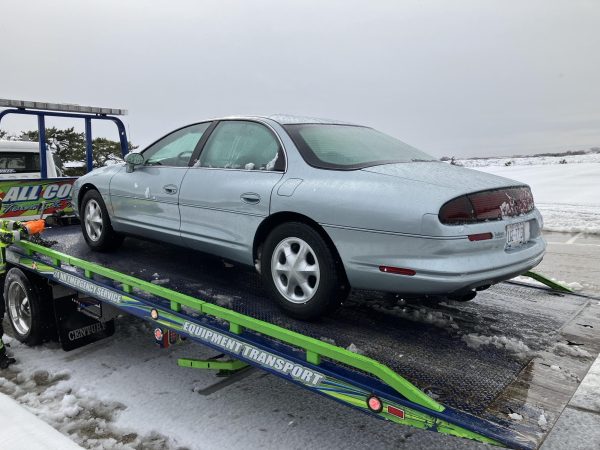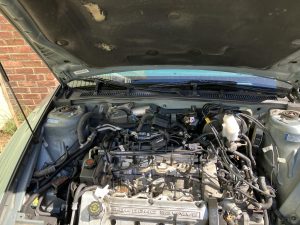It was a great time for engine technology advancement in the 1990’s. We finally departed from the dinosaur push-rod technology of years past and started to get an understanding of how to make powerful engines that comply with modern emissions regulations. Overhead cam engines began to become the norm– these engines were both efficient and powerful and could easily meet emissions regulations with added horsepower and torque. All the major manufacturers slowly joined in on this trend but General Motors and namely Cadillac was deemed the worst of them all, tarnishing the Cadillac nameplate forever.
The Cadillac Northstar series engine seemed good on paper, introduced in 1992 for the 1993 model year Allante, it produced 295 horsepower, and 290 lb-ft of torque. These engines were powerful and touted as one of the smoothest engines ever made, barely audible with the hood closed and inside the car. The sound you could hear sounded like the hum of a sewing machine, so much so, a starter interlock had to be installed so the driver wouldn’t engage the starter while running. They also featured Double overhead cams allowing for higher RPM’s to be achieved and more precise valve timing. All this seemed great on paper but these engines were riddled with problems that arose as these cars gained mileage.
If you ask any mechanic or “car guy or girl” their opinion on the Northstar they will probably say something along the lines of “those things suck”, they leak oil from everywhere, eat camshafts, and the biggest issue of all, blow head gaskets. The Northstar series engines which are well known for their head gasket problems, don’t actually have an issue with the head gaskets themselves, instead it’s actually the head bolts securing the Cylinder Head to the block. Stock, the Cadillac Northstar series had fine thread head bolts that would ‘stretch’ and ‘pull-out’ of the aluminum block causing a loss in pressure in the cylinders. This would force coolant into the cylinders and exhaust system or less commonly into the engine oil, causing coolant loss and overheating, the ‘Northstar Condition’. This is expected to happen at around 100,000 miles, but there are some outliers such as with my car having 62,000 miles. This would be an unfortunate issue for most other cars but for vehicles with the Cadillac ‘Suckstar’, it is catastrophic.
Ok, so you blew the head gasket and want to fix the issue, simple enough, put some oversized head bolts, some new head gaskets, and maybe get the heads resurfaced and call it a day. Nope, in order to do this job, you first have to remove the engine, ok not that bad, kinda expected, but then here’s the curve ball it has to be dropped from the bottom along with the subframe, according to General Motors specifications. This is a job that takes a shop more than 6 hours, and something not really possible for anyone without a car lift. In addition once the engine is removed you are looking at upwards of $1500 for parts, between getting a stud kit, head gaskets, the heads resurfaced, and while doing the work might as well replace every gasket you can access to ‘try’ to stop the never ending oil leaks. For a shop to do this whole job you’re looking at a repair bill of $4,000 or higher, mechanically totaling the vehicle.
Many shops don’t want even anything to do with a Northstar because of how long the job takes, tying up a lift for days on end. For a ‘garage guru’ this task is near impossible due to the fact the engine is supposed to be removed from the bottom, something not easily doable without a lift. In addition this task is going to be much more difficult and take much more time to get done for the average DIY’er in a garage or driveway with no lift. I’m currently doing this job myself on my Oldsmobile Aurora with the 4.0L variant of the Northstar after it blew its head gasket. I’ve probably put about 10 hours into it so far, and still have a few hours to go before the engine is ready to be removed. Once the engine is removed then begins the second part of the job, redoing the head gaskets, and sealing up the oil leaks.


As previously stated, the Northstar engines also like to use oil, and seem to consume camshafts. Other than the constant oil leaks from everywhere, namely the rear main seal, oil pan, and half case gasket being the most common, causing oil loss, they also burn oil because of carbon buildup on the piston rings. If you’re lucky you can pour in a ‘fix it in a bottle’, aka a decarbonizing substance, if you’re unlucky, your ‘fix’ will include dropping the whole motor, and replacing the piston rings. The same is true to resolve oil leaks on the Northstar, the engine must be removed to give you full access to replace the seals around the motor, a multi- thousand dollar job if done at a shop. If the engine is out at that point, might as well repair the head gasket and head bolt issue to prevent it from happening in the future. The cam lobes also tend to wear on the Northstar if they are not driven ‘spiritedly’ from time to time due to lack of oil lubrication from clogged oil ports. When taking a ‘spirited’ drive it gets the engine up to a higher temperature with more pressure, clearing the oil ports, when doing this you risk blowing the head gasket though.
These engines are great if they have been taken care of, and the head bolt job done, just beware if it hasn’t, budget that repair in when buying a Northstar. They are powerful, and extremely technologically advanced, being sported in General Motors top of the line brand, Cadillac. The Northstar was touted as a reliable and powerful engine in the 90’s when it debuted, before the head gasket issues became apparent, and this can still be true if they are properly fixed. Just use caution when buying one, and make sure you have the money to fix it or are ok with selling or junking it when it inevitably blows.










